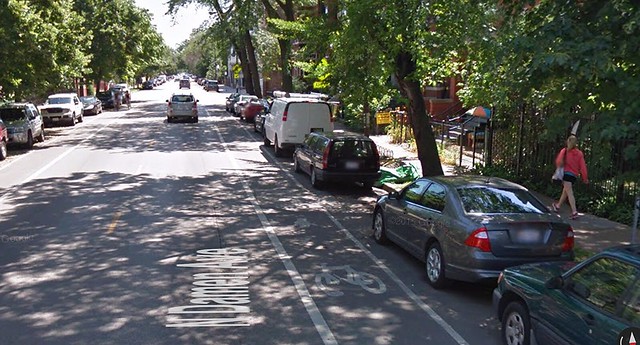At a hearing in the Circuit Court of Cook County last week, a judge denied a motion by the city of Chicago’s law department to dismiss a lawsuit by a female bicyclist who was seriously injured after she struck a hole in one of the Damen bike lanes. The law department argued that the bike lane is “recreational property” and, as such, the city should have limited liability. The plaintiff’s attorney, Brendan Kevenides from FK Law (a Streetsblog Chicago sponsor) argues that if the judge had accepted this reasoning, it would have set a dangerous precedent for local cyclists.
According to the lawsuit, on September 5, 2014, Kirstie Shanley was riding her bike near 1124 North Damen in Ukrainian Village when she struck a sinkhole, which was hard to see because it was filled with water and obscured by a puddle. Shanley, now a 35-year-old occupational therapist, was thrown over her handlebars and suffered significant facial injuries, including broken teeth and bad scarring, Kevenides said.
Following the crash, Shanley called local alderman Scott Waguespack's office. She told them what happened and that she planned to hire an attorney. Soon afterwards, the hole was fixed.
Prior to the crash, someone had circled the hole with red spray paint, which indicated that the city was aware of the hole, according to Kevenides. “Who else would have marked that?” he said. “Of course the city is not responsible for keeping bike lanes in pristine condition – that would be impossible. But they should be held responsible for for failing to repair hazards in bike lanes that they’re aware of, or should be aware of.” Shanley is suing the city for more than $50,000.
Last fall, the law department filed the motion to dismiss, arguing that “the bike lane where Plaintiff claims she fell is recreational property for which the city has tort immunity.” The city cited Section 3-106 of the Tort Immunity Act [emphasis added in the motion]:
Neither a local public entity nor a public employee is liable for an injury where the liability is based on the existence of a condition of any public property intended or permitted to be used for recreational purposes, including but not limited to parks, playgrounds, open areas, buildings or other enclosed recreational facilities, unless such local entity or public employee is guilty of willful and wanton conduct proximately causing such injury.
The law department therefore claimed that, since the city hadn’t willfully or wantonly neglected the maintenance of the bike lane, the suit was invalid.
Law department spokesman Bill McCaffrey told me the department feels Kevenides has mischaracterized its actions. McCaffrey did not provide a full statement on the issue by press time. If they provide a statement, I’ll update this post.
Kevenides told me that bike lanes being classified as recreational facilities would have profound consequences for cyclists. “It would completely immunize the city for any negligence in the way it maintains its bike lanes.
He said the city was trying to take advantage of “recreational immunity,” where a municipality is not liable for negligence in the upkeep of equipment in a recreational area, unless a reckless disregard for the safety of other was demonstrated. Since “willful and wanton conduct” is almost as bad as neglecting maintenance with the intent of injuring people, classifying bike lanes as recreational property would make it much harder for injured cyclists to collect damages, and give the city less incentive to maintain the lanes, Kevenides said.
He argued that the city was essentially trying to extend the notorious Boub versus Township of Wayne ruling, made by the Illinois Supreme Court in 1998. In this case, cyclist John Boub had sued the township after his front wheel got stuck in a gap between bridge planks, throwing him from the bike and causing severe injuries.
This court ruled that cyclists are “permitted” rather than “intended” users of Illinois roadways and, as such, municipalities aren’t responsible for maintaining roads in a manner that is safe for biking. However, according to Kevenides, municipalities are still liable for injuries to cyclists that occur on a marked or signed bike route due to maintenance issues.
“For the law department to claim that bike lanes are simply areas for recreating is a slap in the face to Chicago cyclists, and it seems contrary to the Chicago Department of Transportation's efforts to encourage the use of bike lanes for transportation,” Kevenides said. “I think the law department is dictating to CDOT, ‘Hey, this is a way we can save some money.’ It’s contrary to CDOT's message that bikes are a form of transportation, not just toys.
Notably, in June of 2014, three months before Shanley's crash, the city’s finance committee approved a $1.5 million settlement to a cyclist who was seriously injured in a similar crash in a bike lane on Damen at Wabansia Street, only 5 blocks north of where the recent crash occurred. In 2009, Brian Baker, 23, was permanently disabled after he rode into a collapsed catch basin within the bike lane. The city had two months notice of the condition and had scheduled repairs, but a barricade that should have been in front of the hole was actually in the hole, where it was difficult to see, and the barricade’s light wasn’t working.
Kevenides said the next steps in Shanley’s case are discovery and deposition, and preparing the case for trial. Read his blog post about the city’s recent legal maneuver here.






